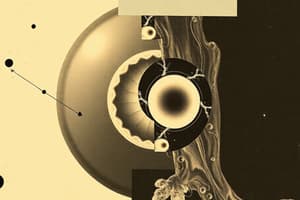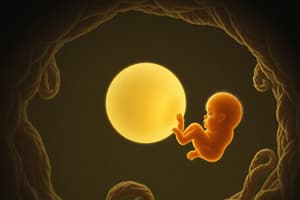Podcast
Questions and Answers
What structure sweeps the oocyte from the ovary into the Fallopian tube?
What structure sweeps the oocyte from the ovary into the Fallopian tube?
- Fimbriae (correct)
- Endometrium
- Uterine lining
- Cilia
Within how many minutes does the fertilization membrane form after a sperm enters the egg?
Within how many minutes does the fertilization membrane form after a sperm enters the egg?
- 30-35 minutes
- 2-5 minutes (correct)
- 20-25 minutes
- 10-15 minutes
What is the term for the series of mitotic divisions that occur after fertilization?
What is the term for the series of mitotic divisions that occur after fertilization?
- Gastrulation
- Blastulation
- Implantation
- Cleavage (correct)
Approximately how many days after fertilization does the zygote develop into a morula?
Approximately how many days after fertilization does the zygote develop into a morula?
In human development, what structure implants into the endometrium approximately 7 days after fertilization?
In human development, what structure implants into the endometrium approximately 7 days after fertilization?
Which of the following structures is formed by the trophoblast?
Which of the following structures is formed by the trophoblast?
What is the inner cell mass (ICM) known as after implantation?
What is the inner cell mass (ICM) known as after implantation?
Which of the following marks the beginning of the Gastrula Stage in embryonic development?
Which of the following marks the beginning of the Gastrula Stage in embryonic development?
What structure is the solid ball of blastomeres?
What structure is the solid ball of blastomeres?
What is the cavity inside the blastocyst called?
What is the cavity inside the blastocyst called?
What two layers is the endometrium divided into after implantation?
What two layers is the endometrium divided into after implantation?
Which of the following structures provides the structural basis for the umbilical cord?
Which of the following structures provides the structural basis for the umbilical cord?
Which primary germ layer gives rise to the epidermis, nervous system, and organs of special senses?
Which primary germ layer gives rise to the epidermis, nervous system, and organs of special senses?
Which primary germ layer gives rise to the GI Tract, urinary tract, liver, gallbladder, pancreas, thyroid, thymus and parathyroid?
Which primary germ layer gives rise to the GI Tract, urinary tract, liver, gallbladder, pancreas, thyroid, thymus and parathyroid?
Which of the following organs is derived from the mesoderm?
Which of the following organs is derived from the mesoderm?
What is the role of the amnion in embryonic development?
What is the role of the amnion in embryonic development?
Which of the extraembryonic membranes is responsible for providing the embryo's first blood cells?
Which of the extraembryonic membranes is responsible for providing the embryo's first blood cells?
What is the correct chronological order of the following stages of early embryonic development: morula, zygote, blastocyst, gastrula?
What is the correct chronological order of the following stages of early embryonic development: morula, zygote, blastocyst, gastrula?
Why is the formation of the fertilization membrane important?
Why is the formation of the fertilization membrane important?
How do trophoblast cells contribute to implantation?
How do trophoblast cells contribute to implantation?
After implantation, what happens to the trophoblast cells?
After implantation, what happens to the trophoblast cells?
What is the primary role of the yolk sac during early human embryonic development?
What is the primary role of the yolk sac during early human embryonic development?
You're examining a sample under a microscope and observe a solid ball of approximately 32 cells. Based on your knowledge of human development, what stage is this most likely to be?
You're examining a sample under a microscope and observe a solid ball of approximately 32 cells. Based on your knowledge of human development, what stage is this most likely to be?
What process do the trophoblast cells use to penetrate the endometrium?
What process do the trophoblast cells use to penetrate the endometrium?
If the ectoderm failed to develop properly during gastrulation, which of the following systems would be MOST affected?
If the ectoderm failed to develop properly during gastrulation, which of the following systems would be MOST affected?
Which of the following is the most accurate description of the gastrula stage?
Which of the following is the most accurate description of the gastrula stage?
A researcher is studying the effects of certain toxins on early embryonic development. They observe that the allantois is severely malformed in the exposed embryos. What is the MOST likely long-term consequence of this defect?
A researcher is studying the effects of certain toxins on early embryonic development. They observe that the allantois is severely malformed in the exposed embryos. What is the MOST likely long-term consequence of this defect?
A woman is diagnosed with a condition that prevents the formation of the fertilization membrane. What is the MOST likely immediate consequence of this condition if fertilization were to occur?
A woman is diagnosed with a condition that prevents the formation of the fertilization membrane. What is the MOST likely immediate consequence of this condition if fertilization were to occur?
A certain drug is known to inhibit the secretion of enzymes by trophoblast cells. What specific process in early embryonic development would be MOST directly affected by this drug?
A certain drug is known to inhibit the secretion of enzymes by trophoblast cells. What specific process in early embryonic development would be MOST directly affected by this drug?
If the mesoderm layer of an embryo failed to properly differentiate, which of the following structures would NOT develop correctly?
If the mesoderm layer of an embryo failed to properly differentiate, which of the following structures would NOT develop correctly?
Which of the following mechanisms plays the MOST direct role in preventing polyspermy?
Which of the following mechanisms plays the MOST direct role in preventing polyspermy?
After fertilization, the zygote undergoes rapid cell division without an increase in overall size. What is this process called?
After fertilization, the zygote undergoes rapid cell division without an increase in overall size. What is this process called?
What is the correct order of events leading to implantation?
What is the correct order of events leading to implantation?
A scientist discovers a compound that prevents the formation of the allantosis. Which function of the developing embryo would be most immediately affected?
A scientist discovers a compound that prevents the formation of the allantosis. Which function of the developing embryo would be most immediately affected?
During gastrulation, a critical signaling error causes a complete failure of mesoderm formation. Which of the following structures would be MOST affected by this error?
During gastrulation, a critical signaling error causes a complete failure of mesoderm formation. Which of the following structures would be MOST affected by this error?
Consider a developing embryo where a genetic mutation prevents the proper folding and migration of cells during gastrulation. If the endoderm layer failed to form correctly, which of the following processes would be MOST directly compromised?
Consider a developing embryo where a genetic mutation prevents the proper folding and migration of cells during gastrulation. If the endoderm layer failed to form correctly, which of the following processes would be MOST directly compromised?
A researcher is designing a drug that will prevent implantation of a blastocyst but wants to minimize side effects on the mother. Which of the following mechanisms would be the MOST specific and effective target for this drug?
A researcher is designing a drug that will prevent implantation of a blastocyst but wants to minimize side effects on the mother. Which of the following mechanisms would be the MOST specific and effective target for this drug?
In a hypothetical scenario, researchers succeed in creating artificial trophoblast cells that, while structurally sound, are incapable of secreting Human Chorionic Gonadotropin (hCG). How would this MOST directly impact early pregnancy?
In a hypothetical scenario, researchers succeed in creating artificial trophoblast cells that, while structurally sound, are incapable of secreting Human Chorionic Gonadotropin (hCG). How would this MOST directly impact early pregnancy?
Flashcards
Fimbriae function
Fimbriae function
Sweep oocyte from ovary into Fallopian Tube where sperm may be met.
What is a zygote?
What is a zygote?
Cell resulting from the fusion of sperm and egg.
Fertilization membrane
Fertilization membrane
Membrane forms beneath egg's jelly coat preventing additional sperm from entering.
What is cleavage?
What is cleavage?
Signup and view all the flashcards
Blastomeres
Blastomeres
Signup and view all the flashcards
What is a morula?
What is a morula?
Signup and view all the flashcards
Blastocyst
Blastocyst
Signup and view all the flashcards
Trophoblast
Trophoblast
Signup and view all the flashcards
Inner Cell Mass (ICM)
Inner Cell Mass (ICM)
Signup and view all the flashcards
Decidua basalis
Decidua basalis
Signup and view all the flashcards
Decidua capularis
Decidua capularis
Signup and view all the flashcards
Gastrula Stage
Gastrula Stage
Signup and view all the flashcards
Endoderm
Endoderm
Signup and view all the flashcards
Mesoderm
Mesoderm
Signup and view all the flashcards
Ectoderm
Ectoderm
Signup and view all the flashcards
Amnion
Amnion
Signup and view all the flashcards
Yolk sac
Yolk sac
Signup and view all the flashcards
Allantois
Allantois
Signup and view all the flashcards
Study Notes
- Fimbriae sweeps the oocyte from the ovary into the Fallopian tube.
- The oocyte can potentially meet sperm in the Fallopian tube.
- The entry of sperm into the oocyte, creating a zygote.
- A fertilization membrane forms beneath the egg's jelly coat within 2-5 minutes, blocking additional sperm from entering when fertilization happens.
Cell Development
- The zygote divides after fertilization.
- The fertilized egg forms a mass of successively smaller cells called Blastomeres.
- The series of mitotic divisions is cleavage.
- Two days after fertilization the zygote is at the 4 cell stage, still in the fallopian tube.
- After Three days, the zygote develops into a morula.
- The Morula is a solid ball of 32 blastomeres that resembles a berry that remains in the fallopian tube.
- After four days, the morula has entered the uterus and turned into a blastocyst.
- The early blastocyst hollows out, and the zona pellucida degenerates as the blastocyst enters the uterus.
- After seven days, the blastocyst consists of trophoblast cells, an inner cell mass, and a blastocyst cavity.
- At day seven, the blastocyst begins implanting in the endometrium.
Trophoblast and Inner Cell Mass
- The Trophoblast becomes the chorion.
- Chorion is the extra-embryonic membrane that forms the fetal placenta.
- Trophoblast cells release enzymes to degrade the endometrium and reach blood vessels.
- Once implantation is complete about 14 days post-fertilization, the trophoblast differentiates into a chorion that lie in blood-filled sinusoids of uterine tissue.
- Exchanges occur to and from the embryo during this time.
- The Inner Cell Mass (ICM) becomes the embryonic disc, and will eventually form the embryo.
- The endometrium below the ICM after implantation is called the decidua basalis while endometrium above the ICM is called the decidua capularis.
- After implantation is complete, embryo development proceeds to the gastrula stage.
Gastrula Stage: Three-Layer Embryo
- A three-layered embryo forms, where each layer corresponds to a primary germ layer from which all body tissues develop.
- The Endoderm is the inner layer that forms the GI tract, urinary tract, liver, gallbladder, pancreas, thyroid, thymus, and parathyroid.
- Mesoderm is the middle layer that forms the dermis, skeleton, muscle, cartilage, blood vessels, kidneys, internal reproductive organs, and adrenal cortex.
- The Ectoderm forms the epidermis, nervous system, sense organs, nasal cavity, anal cavity, adrenal medulla, pituitary, and pineal glands.
Extra Features of Embryo
- Amnion encases the young embryo in a fluid-filled chamber.
- The amnion protects the embryo from mechanical trauma and rapid temperature fluctuations.
- Yolk Sac loses its original function but still provides the embryo's first blood cells.
- Allantois forms from the posterior end of the yolk sac.
- The Allantois establishes the structural basis of the umbilical cord.
Studying That Suits You
Use AI to generate personalized quizzes and flashcards to suit your learning preferences.




